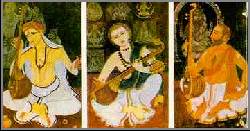HOME MUSIC

The History of South Indian music
The origins of Indian music are
traced to prehistoric antiquity. One widespread theory holds that
there has been a gradual development from simple forms and
techniques to more complex ones.
On the other hand, the rich store
of melody, rhythm and instrumental technique found among tribal
musicians makes it probable that sophisticated music emerged long
before theoretical rules (lakshana) were framed for the first
time almost two thousand years ago.Art or concert music in South
India is called Karnataka Sangitam ("Karnatic music" in
English). Its history gains sharper contours from the
Renaissance period which, in South India, had its centre in the
Vijayanagar empire (1336-1565). Ramamatya, a 16th century music
scholar at Vijayanagar, laid the foundations for the present
theoretical framework of South Indian music.
The present system of 72 scales (melas)
was developed on the foundations laid by Venkatamakhin in the 17th
century. Perfected by later theoreticians, the mela-janya raga
system provided composers with virtually unlimited scope for melodic
variety.
The system of ten scales (that)
presently followed by most North Indian (Hindustani)
musicians is also based on the mela or melakarta system. However,
because of its accuracy, internal consistency and differentiation,
some leading Hindustani musicians have begun to adopt the southern
system of 72 melas in preference to the system of thats which V.N.
Bhatkhande had developed and introduced earlier in this century.
These highly educated performers pursue a music that, although
rooted in tradition, has greater scope for their imagination and
virtuosity.

The
History of Carnatic Music
Carnatic music originated in the fertile plains of the Cauvery delta
and flourished through the ages. Vaggeyakaras are the persons
who composed many songs which are rendered in its original form to
date. The Trinities of Carnatic music, Saint Thyagaraja, Muthuswamy,
Dikshithar and Syama Shastri were all born in Thiruvarur near
Thanjavur and the songs composed by them have explored & exhibited
the depth and the rich feeling in this form. The other notable
composers are Patnam Subramaniya Iyer, Papanasam Sivan, Raja Swathi
Thirunal, Annamacharyar, Purandaradasar.
The subject matter of the songs mainly dealt with the various Gods and
Goddesses, extolling their lives, their virtues, reflecting the varied
moods of humans like happiness, gratitude, fear, sorrow. Though
Composers have also dealt with subjects like patriotism, natures
bounty etc., their soul and heart were to a very great extent limited
to the deities they considered prime. Music was also looked upon as a
means of attaining Moksha ( Salvation ).
Sa Re Ga Ma Pha Dha Nee are the seven
basic notations called the Sapthaswaras. The swaras Sa & Pa help
select the sruthi/pitch of the singer. Re (Rishaba) & Gha (Ghandaram)
are of three types each, Ma (Madhyamam) of 2 types, Dha (Dhaivatham)
and Nee (Nishadham) of three types each and when grouped together
these variations (6,2,6) combined to form the 72 main ragas, the
Melakarthas. The Melakarthas are divided as Suddha Madhyama and Prathi
Madhyama ragas based on their madhyama(ma) variations by Venkata Mahi
as Venkata Mahi Chakra.
Ragas born from Melakartha Ragas are
aptly termed as Janya Ragas. Janya Ragas are classified into three
categories viz., Sampoornam - seven swaras, Shadavam - six swaras and
Oudavam - 5 swaras. Janya ragas follow the Kartha raga ie., they
contain the same swaras of the original raga in various permutations
and 483 variations becomes apparent to form 34,766 Janya Ragas.
The Janya Ragas gets further
subdivided as Upanga Raga, Bhasanga Raga and Vakra Raga. Upanga Raga
allows for deletions and additions of swaras. Bhasanga Raga has swaras
in addition to swaras from its original raga and the Vakra Raga has
swaras in a non-sequential order.
The Ragas either follow an ascending
order, " Aarohanam" or a descending order the "Avarohanam"
and the composers took great care to adhere to the various rules when
composing a song.The song composed are set to thala depending on the
number of beats. The thalas are divided into Thisra - three, Misra -
four, Kanda - five, Sadhusra - seven, Sankeernam - nine and the song
composed fits into one of the above. Aadhi, Rupakam and Chapu are some
of the Thalas.The confluence of the Ragas and the Thalas have from
early times been providing us with melodious patterns which when
rendered with bhava (feeling) is an experience that has to be had to
be believed.
How
do you learn Carnatic music
A systematic learning of Carnatic music under a competent teacher
enables one to sing in a disciplined manner with adherence to the
laid down rules with an understanding of the concept of Carnatic
music Even a prodigious talent needs the guidance of a guru
(teacher) to shape and polish his genius. There are various stages
of learning Carnatic music, starting from the Swaravali (Sarali
Varisai) which train and tune the voice and the mind. Purandaradasa
developed a system of teaching Carnatic music, starting with Sarali
Varisai in Mayamalavagowlai ragam and gradually built up till Gitam.
This pattern is being followed even today. Purandaradasa was the
trendsetter in developing a teaching methodology for Carnatic music
and is hailed as the "Father of Carnatic music".
Depending
on the range and quality of the voice, the pitch is selected. The
pitch is called "sruti" in Carnatic music. Clean adherence
to sruti is the mark of a good singer.

